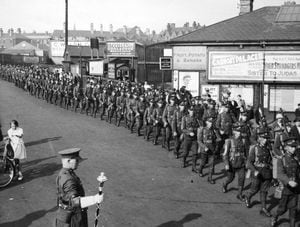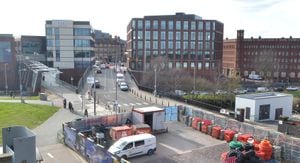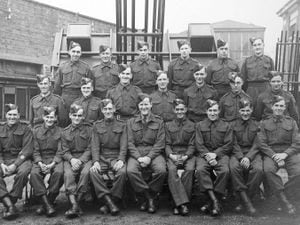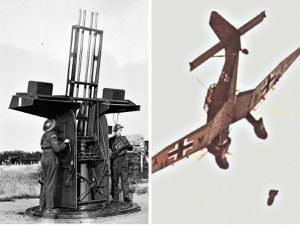From marching soldiers to office development: Photos show 90 years of change in Wolverhampton city centre
Don't get too sorry for these marching soldiers – they're going on holiday.

Well, their annual camp, anyway.
Nearly 90 years separate these two pictures of Wolverhampton and you can see for yourselves how things have changed in that time as we look up Railway Drive, then and now.
The soldiers are from the Wolverhampton Companies of the 6th Battalion of the South Staffordshire Regiment and they are making their way to the railway station to catch a train (or trains) to take them to their annual camp, being held in Pwllheli, Wales.
The date is Sunday, August 6, 1933.
Some of the posters tell us what was about to be on at the flicks at that time – and the soldiers would miss. One is for the Gaumont Palace cinema. The movie advertised, "Sister to Judas," was on the supporting bill for the main feature, with Jack Holt and Lilian Bond, called "When Strangers Marry," which was being shown at the cinema on August 8 and 9.
The Gaumont Palace cinema will have been quite new at the time, having opened at Snow Hill in 1932.
Other cinemas and theatres were available, like the Grand Theatre (still going, of course), the Hippodrome (with Jimmy James starring in "All For Pleasure"), the Queen's Picture House, the Scala, the Globe, the New Theatre Royal, the Coliseum, the Olympia...

Some landmark Wolverhampton buildings can be seen in the distance. The one with the long roof and lots of chimneys is the Britannia Hotel in Lichfield Street, while the one just right of centre with the dome on the corner is the Prince Albert.
And if that building in the foreground on the right wasn't there, we'd be able to make out the Chubb works.
The weather for the South Staffords' annual camp seems to have been good, as a picture appeared in the Star a few days later of them cooling their feet in tubs of water after a 12-mile route march in summer heat.
The headquarters wing won the battalion cup in the battalion sports "chiefly as a result of the excellent running of the drummers, particularly in the relay races."
Among the events were a wheelbarrow race, an old soldiers' race, and a mounted potato race, whatever that might be.
Naturally, being the Army, there were some dreary inspections to be endured as well.
The Earl of Harrowby, Lord Lieutenant of Staffordshire, inspected various units on a visit to the camp on August 18 – it seems they were away for a fortnight – and the previous day the inspecting officer was Colonel W J Cranston, DSO, who commanded the 137th Staffordshire Infantry Brigade. He expressed his satisfaction at the smartness of the men.
Our modern comparison picture shows how the skyline of modern Wolverhampton is changing. You can glimpse the Britannia in the centre distance, but as you can see a lot of redevelopment is, and has been, going on.
Centre, the dominating building with lots of windows is i9, a six-storey office development which is almost brand new – the official start of work was only in December 2019. It is part of the Wolverhampton Interchange scheme which won the Royal Town Planning Institute West Midlands Award for Planning Excellence 2020.
Its design has been influenced by the city's red-brick Victorian buildings. You can see how it seems to mimic the Chubb works on the right.
It made history of sorts, when the first government ministerial department outside London opened its doors there in September. The Ministry of Housing, Communities and Local Government opened a new base across two floors.
On the other side of the road is i10, another development which has helped transform the look of 21st century Wolverhampton. It's a bit older than i9, but not much, being completed around the end of 2015, and is offices, leisure, and retail space.
And there's more to come...





